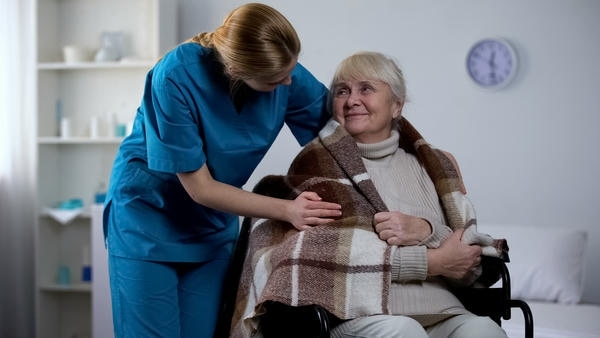The late afternoon sun cast long shadows through the windows of Pine Grove Care Home as Emily Matthews gathered her thoughts at the nurse’s station. After six years as a professional caregiver, she had learned that some days left deeper impressions than others. Today was one of those days. Her patient, Mrs. Henderson, had experienced a particularly difficult morning, struggling with confusion and anxiety – common challenges for someone living with advanced dementia. But what made the day especially poignant was the visit from Mrs. Henderson’s daughter, Susan, whose face had crumpled with emotion upon seeing her mother unable to recognize her for the third time this week.
The Delicate Dance of Caregiving
The relationship between caregivers, elderly patients, and their families often resembles an intricate dance, where each partner must move in harmony to maintain balance and grace. In Ontario’s growing elderly care community, this dance becomes increasingly complex as families navigate the challenges of aging parents while trying to maintain their own work-life balance. The story of Emily and the Hendersons illustrates a common scenario playing out in thousands of homes and care facilities across the province, where effective communication serves as the choreography that keeps everyone moving together.
Understanding the Family’s Journey
When Emily first met Susan Henderson, she recognized a familiar look in her eyes – a mixture of guilt, fear, and overwhelming love. Susan, like many adult children, had struggled with the decision to seek professional care for her mother. “I promised Dad I would take care of her,” Susan had confided during their first meeting, her voice breaking slightly. “But between my job in Toronto, my teenagers, and Mom’s increasing needs, I felt like I was drowning.”
This confession became the foundation of their relationship, helping Emily understand that behind every family’s decision to seek care lies a complex tapestry of emotions, promises, and practical realities. In Ontario, where approximately 3.3 million people are caregivers to family members or friends, the emotional weight of these decisions is a shared experience that deserves acknowledgment and support.
The Power of Perspective-Taking
Emily’s approach to building trust with families began with a simple yet powerful practice: perspective-taking. She understood that for Susan, every visit to Pine Grove represented not just a chance to see her mother, but also a confrontation with change and loss. “Sometimes, families need us to be more than just caregivers,” Emily often told her colleagues. “We need to be witnesses to their journey, acknowledging both their struggles and their unwavering dedication to their loved ones.”
This understanding manifested in small but meaningful ways. When Susan visited, Emily would share not just the challenges of the day, but also the moments of joy – how Mrs. Henderson’s face lit up when they played her favorite Frank Sinatra records, or how she still hummed along to the hymns from her church days. These stories became bridges, connecting Susan to the mother she remembered while helping her accept who her mother was becoming.
Creating a Circle of Care
The concept of a “circle of care” became central to Emily’s communication strategy. Rather than positioning herself as the primary caregiver, she worked to create an inclusive environment where family members felt like essential partners in care decisions. This approach proved particularly valuable when navigating the complex healthcare system in Ontario, where coordination between various healthcare providers, family members, and support services can often feel overwhelming.
For the Hendersons, this meant regular family meetings that included not just Susan, but also her brother David, who joined via video call from Vancouver. These meetings became forums for sharing updates, discussing concerns, and most importantly, celebrating small victories. “Remember when Mom couldn’t sleep through the night?” Susan remarked during one such meeting. “Now she’s actually following a routine, and I can see what a difference it makes.”
Transforming Communication into Connection
As the healthcare landscape continues to evolve, particularly in the wake of recent global challenges, the importance of meaningful communication between caregivers and families has become even more apparent. Emily’s experience with the Hendersons highlights several key strategies that have proven effective in building and maintaining these vital connections.
The Art of Active Listening
One autumn afternoon, as Susan sat in Mrs. Henderson’s room watching her mother doze, she began sharing stories from her childhood. Emily, who had been adjusting Mrs. Henderson’s blankets, found herself drawn into these memories. Instead of continuing with her tasks, she sat down and listened. This simple act – the decision to be present and attentive – opened up a new dimension in their relationship.
Through active listening, Emily learned about Mrs. Henderson’s life as a music teacher, her famous Christmas cookies, and the way she would leave little notes in her children’s lunchboxes. These stories became valuable tools in Mrs. Henderson’s care, providing conversation topics during difficult moments and helping to maintain connections to her past.
Technology as a Bridge
In today’s digital age, technology has become an invaluable tool for maintaining connections between caregivers and families. Emily embraced this reality by implementing a secure messaging system that allowed her to send regular updates to both Susan and David. These weren’t just clinical reports; they included photos of Mrs. Henderson enjoying activities, short videos of her better moments, and quick notes about daily achievements.
For Susan, who often felt guilty about not visiting more frequently due to her demanding job in Toronto, these digital updates became a lifeline. “It’s like having a window into Mom’s daily life,” she explained. “Even on days when I can’t be there physically, I feel connected to what’s happening.”
Building Trust Through Transparency
Transparency in communication became the cornerstone of trust between Emily and the Henderson family. This meant being honest about both progress and setbacks, explaining care decisions clearly, and admitting when she didn’t have all the answers. When Mrs. Henderson experienced a fall, Emily immediately contacted the family, explaining not just what had happened but also the preventive measures being put in place to avoid future incidents.
This commitment to transparency extended to discussing the realities of dementia’s progression. Rather than offering false hope or hiding difficulties, Emily helped the family understand what to expect while always emphasizing the ways they could continue to connect with their mother meaningfully.
The Role of Empathy in Professional Care
As weeks turned into months, Emily’s relationship with the Henderson family deepened through a shared commitment to Mrs. Henderson’s well-being. The professional boundaries remained clear, but within them grew a profound understanding of each other’s roles in this journey. Susan began to see Emily not just as her mother’s caregiver but as an ally in navigating the complex emotional landscape of aging and memory loss.
One particularly challenging day, after Mrs. Henderson had become agitated and confused, Susan found herself overwhelmed with emotion. Instead of trying to fix the situation with words, Emily simply sat with her in silence, offering the kind of understanding that comes only from shared experience. “It’s okay to feel this way,” Emily finally said. “Your love for your mother shows in everything you do, including the hard decisions you’ve had to make.”
Conclusion: A Shared Journey
As the sun sets on another day at Pine Grove Care Home, Emily reflects on the journey she has shared with the Hendersons. The path hasn’t always been smooth, but through consistent, compassionate communication, they have created something valuable – a partnership built on trust, understanding, and shared purpose.
For caregivers and families embarking on this journey, the message is clear: effective communication is more than just exchanging information. It’s about creating connections, building bridges, and recognizing that in the complex world of elderly care, we are all partners in providing the best possible care for our loved ones.
As Mrs. Henderson settles in for the evening, humming softly to a familiar tune, Emily sends a quick update to Susan. It’s a small gesture, but one that represents the countless threads of communication that weave caregivers, families, and patients together in the tapestry of care.






For most recent information you have to pay a quick visit the web
and on web I found this website as a most excellent site for most up-to-date updates.
I don’t know whether it’s just me or if perhaps everybody else experiencing issues with your website.
It appears as if some of the written text in your posts are running off the screen. Can someone
else please provide feedback and let me know
if this is happening to them too? This could be a problem with my web browser because I’ve had this happen previously.
Appreciate it
I used to be suggested this blog by way of my cousin. I’m not sure whether this
publish is written by him as nobody else recognise such designated approximately my
problem. You are amazing! Thanks!
Unquestionably believe that which you said. Your favourite justification seemed to be at the internet the easiest factor to have in mind
of. I say to you, I certainly get annoyed at the same time as folks think about
issues that they plainly don’t realize about.
You managed to hit the nail upon the top and defined
out the whole thing with no need side-effects
, people can take a signal. Will probably be again to get more.
Thank you
Great article, just what I needed.
Regards for all your efforts that you have put in this.
Very interesting information.
I just now wanted to thank you one more time for the amazing blog you have developed
here. It’s full of ideas for those who are definitely interested in that subject, primarily this very post.
You really are all really sweet as well as thoughtful of others in addition to the fact that
reading your site posts is a great delight in my opinion. And what generous surprise!
Ben and I are going to have excitement making use
of your points in what we have to do next week. Our record
is a distance long and simply put tips is going to be put to good use.
I know this if off topic but I’m looking into starting my own blog and was
wondering what all is required to get set up? I’m
assuming having a blog like yours would cost a pretty penny?
I’m not very web smart so I’m not 100% positive.
Any recommendations or advice would be greatly
appreciated. Thanks